When buildings speak : architecture as language in the Habsburg Empire and its aftermath, 1867-1933 /
Saved in:
| Author / Creator: | Alofsin, Anthony. |
|---|---|
| Imprint: | Chicago : University of Chicago Press, 2006. |
| Description: | xi, 326 p. : ill. (some col.), col. maps ; 29 cm. |
| Language: | English |
| Subject: | |
| Format: | Print Book |
| Local Note: | University of Chicago Library's c.2 is in hardcover and has original dustjacket; c.3 is in softcover. |
| URL for this record: | http://pi.lib.uchicago.edu/1001/cat/bib/6159409 |
| Summary: | In When Buildings Speak ,Anthony Alofsin explores the rich yet often overlooked architecture of the late Austro-Hungarian Empire and its successor states. He shows that several different styles emerged in this milieu during the late nineteenth and early twentieth centuries. Moreover, he contends that each of these styles communicates to us in a manner resembling language and its particular means of expression. <br> Covering a wide range of buildings--from national theaters to crematoria, apartment buildings to warehouses, and sanatoria to postal savings banks--Alofsin proposes a new way of interpreting this language. He calls on viewers to read buildings in two ways: through their formal elements and through their political, social, and cultural contexts. By looking through Alofsin's eyes, readers can see how myriad nations sought to express their autonomy by tapping into the limitless possibilities of art and architectural styles. And such architecture can still speak very powerfully to us today about the contradictory issues affecting parts of the former Habsburg Empire.<br> <br> "The book itself as a production is spectacular."--David Dunster, Architectural Review |
|---|---|
| Physical Description: | xi, 326 p. : ill. (some col.), col. maps ; 29 cm. |
| Bibliography: | Includes bibliographical references (p. [295]-310) and index. |
| ISBN: | 0226015068 9780226015064 |

